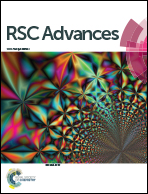Highly fluorescent carbon dots as an efficient nanoprobe for detection of clomifene citrate†
Abstract
Highly fluorescent carbon dots (CDs) were synthesized through facile hydrothermal carbonization and ethylenediamine passivation of an easily available prawn shell precursor. The as-prepared CDs exhibit high water solubility, wavelength-tunable fluorescence with quantum yield up to 68.9%, high photostability and resistance against biomolecules, thus enabling the application as viable fluorescent nanoprobes for detection of guest quenchers. The fluorescence of the CDs can be effectively quenched by clomifene citrate (CC, a common drug for infertility) through static quenching, and therefore can serve as a simple and efficient fluorescent nanoprobe for determination of CC with wide linear range (0.25–10 μg mL−1) and low detection limit (0.2 μg mL−1). The CDs also showed low cytotoxicity, which enables the safe and accurate fluorescent detection of spiked CC in human serum, demonstrating their potential as a credible fluorescent CC nanoprobe in clinical examination.



 Please wait while we load your content...
Please wait while we load your content...